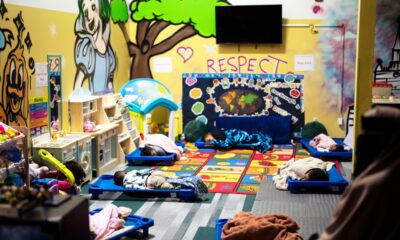California
Depression was rising among young people in Southern California. COVID made it worse

Children, teens and young adults in Southern California had been grappling with rising rates of depression and anxiety for years before the pandemic. Then COVID-19 came along and made their mental health struggles even worse.
Among 1.7 million young patients who were part of the Kaiser Permanente Southern California health system, the prevalence of clinically diagnosed depression was 60% higher in 2021 than it had been five years earlier, according to a new study. The prevalence of anxiety among young patients who did not have depression also rose by 35% during that period, researchers found.
For both conditions, the annual rate of increase was significantly higher during the pandemic years of 2020 and 2021 than in the three years that preceded them.
What’s more, the trend was seen across all demographic groups regardless of age, gender, race, ethnicity or income, according to the report published Tuesday in JAMA Network Open.
“COVID initially was considered an infectious-disease crisis,” said Dr. Siddhartha Kumar, a child and adolescent psychiatrist at Kaiser and the study’s senior author. “This was another side of COVID. The side effects on mental health are long-lasting and impacted the society in a very major way.”
It’s no secret that young people have been suffering.
In 2016, when the National Survey of Children’s Health asked parents and other caregivers how their youngsters were faring, their responses indicated that 3.1% of kids ages 3 to 17 were depressed. By 2020, that figure was 4%.
That survey also found that the prevalence of anxiety among those children increased from 7.1% to 9.2% during the same period.
Another study of adolescents ages 12 to 17 who participated in the 2021 National Survey on Drug Use and Health found that 20% of them had experienced major depressive disorder in the past year.
And U.S. Surgeon General Vivek Murthy focused the nation’s attention on the issue by issuing a public health advisory about youth mental health in 2021. The advisory cited studies that found 25% of children and teens ages 4 through 17 from around the world had experienced symptoms of depression during the pandemic while 20% had symptoms of anxiety. Both measures had doubled since the start of the pandemic.
The new study is believed to be the first large-scale examination of youth mental health in the COVID era based on official diagnoses rather than survey data, according to Kumar and his colleagues from Kaiser Permanente Southern California, whose territory extends from Ventura County to the Inland Empire and from Kern County to San Diego.
The study authors focused on the roughly 1.7 million health plan members who were between the ages 5 and 22 on the first day of at least one of the years between 2017 and 2021.
Those children and young adults reflected the diversity of Southern California as a whole, the researchers wrote. About half were Latino, 23% were white, 8% were Asian and 8% were Black. (Data were missing for some plan members.)
Slightly more than half — 55% — were from households with an annual income of $50,000 to $99,999. An additional 29% were from households that earned less, and 16% were from ones that earned more.
The researchers checked whether the young patients had been formally diagnosed with some form of clinical depression. To qualify, a doctor had to determine that a patient was experiencing a “sad or irritable mood or loss of interest in activities” that caused “significant impairment in daily life.”
They found that 1.35% of the patients were newly diagnosed with depression in 2017. That figure rose to 1.58% in 2018, 1.76% in 2019, 1.84% in 2020 and 2.1% in 2021, with the incidence increasing for all groups regardless of age, gender, race, ethnicity or income.
Teens of high school age, 14 to 17, and young adults old enough to be in college, 18 to 22, had the highest incidences of depression throughout the study, the researchers found. Generally speaking, girls and women were more likely to be diagnosed with depression than boys and men, and the risk was consistently higher for patients who were white and who came from households with the highest incomes.
When the researchers tallied all the children and young adults with a new or existing depression diagnosis, they found that the prevalence was 2.55% in 2017, 2.92% in 2018, 3.27% in 2019, 3.53% in 2020 and 4.08% in 2021. The annual rate of increase was higher during the pandemic than before it, and the difference was large enough to be statistically significant, the researchers said.
They also examined patients diagnosed with anxiety, a condition they said was characterized by “excessive feelings of worry or persistent, even intrusive thoughts about certain fears or constant fear in general.”
Nearly 37% of the young patients with anxiety had also been diagnosed with depression. The researchers set them aside and focused on the ones who had anxiety alone.
By that measure, the incidence of newly diagnosed cases was 1.77% in 2017, 2.03% in 2018, 2.1% in 2019, 1.93% in 2020 and 2.32% in 2021.
College-age young adults had the highest incidence of anxiety without depression. The risk was also higher for people who were white and were in the highest income bracket, according to the study.
The prevalence of new or existing anxiety in patients without depression followed a similar pattern — 3.13% in 2017, 3.51% in 2018, 3.75% in2019, 3.61% in 2020 and 4.22% in 2021.
Both new and total cases of anxiety without depression increased significantly more in the COVID years than in the ones preceding it, the researchers found.
“Anxiety, mild depression, hopelessness, disappointment — these are common feelings all of us have from time to time. But it’s another thing when it reaches a clinical level,” Kumar said.
And when that happens to young people, the effects can be enduring.
“The teenage years are when you build your sense of self,” he said. “When adults go through stressful situations in their lives, often their reactions are based on how their sense of self was when they were young.”
Christina Bethell, a social epidemiologist and director of the Child and Adolescent Health Measurement Initiative at Johns Hopkins University, agreed that the pandemic had exacerbated a mental health crisis affecting young people nationwide. But she said medical records could not capture the full scope of the problem.
Patients with depression or anxiety may not have access to a doctor, and those who do might not feel comfortable seeking treatment, she said. Primary care doctors are supposed to screen adolescents and adults for depression, but that doesn’t always happen. Even when it does, patients may not answer screening questions honestly. Sometimes doctors make mistakes that lead to misdiagnosis. And sometimes a patient who was correctly diagnosed recovers from depression or anxiety, but their medical records aren’t updated to reflect that.
“Medical records are often wrong, incomplete and only available for those in healthcare,” said Bethell, who wasn’t involved in the study.
In her view, the most important question isn’t whether someone has a diagnosis of depression or anxiety, but how they are actually faring.
“There are a whole bunch of people with a diagnosis who flourish, and there are people without a diagnosis who don’t flourish,” she said. “We want to keep our eye on the prize, which is youth well-being.”

California
California’s gubernatorial race heats up as Newsom’s term nears end, with many contenders

FRESNO, Calif. (FOX26) — In just over a year, Gavin Newsom’s term as California’s governor will come to an end, capping off nearly eight years in office.
Now the question is – who will take over once he steps down?
We spoke to political scientist Nathan Monroe about what could be one of Californias most unpredictable gubernatorial races yet.
With Governor Gavin Newsom’s term ending, the race to replace him begins.
This race will determine who leads the worlds fifth largest economy at a time when California is facing issues such as housing and affordability.
Californias next gubernatorial election is shaping up to be crowded – and for the first time in years – there’s no incumbent on the ballot.
“You say, well, just which democrat is going to win, right? Like, sort of republicans don’t have a shot. But what we have to keep in mind, right, is that the rules of elections matter. And in California, we have the top two primary system,” said Nathan Monroe, a Political Science Professor at UC Merced.
More than a dozen candidates are vying for the spot.
On the democratic side, contenders include former U.S. Secretary of Health and Human Services Xavier barrera, former U.S. Representative Katie Porter, Representative Eric Swalwell, former Los Angeles Mayor Antonio Villaraigosa, and former State Controller Betty Yee.
Political experts say the size of the field could make turnout and name recognition decisive and could lead to unexpected results in the primary.
“But if you divide that pie up by just two, and you divide the democratic pie up, which is admittedly a larger pie, by 7 or 8, the concern you get here is that democrats are going to lose out on even running to the general election. So even though there might be more democratic votes to be found in California for governor, they might not have a shot to cast those ballots for a democrat on the general election ballot,” said Monroe.
Monroe says party leaders may need to step in soon.
“I think the concern has to be among voters and I’m sure among the party leaders, so to speak, right, the party leaders sort of amorphously, is that they’ve got to figure out a way to delicately, you know, assure some candidates out of the race and figure out which candidates those should be and figure out how to manage those personalities and try to coordinate all the things that go in and around a gubernatorial election,” said Monroe.
On the Republican side, former Riverside County Sheriff Chad Bianco and Fox News contributor Steve Hilton.
With just a few months from the midterm elections, Monroe says both parties need to organize.
“What’s happening behind the scenes for the parties to try to coordinate themselves to make sure that the field that they offer to voters in June is a field that gives them the best chance for their best candidate to go forward to the general election,” said Monroe.
The primary election is set for June, with the general election in December.
California
Heavy rain, high tides cause flooding along stretch of Northern California
CORTE MADERA, Calif. (AP) — Heavy rain and high tides believed to be the most severe in two decades caused flooding in parts of Northern California on Saturday, prompting road closures and rescues of residents trapped in their cars.
Roadways through a 15-mile (24-kilometer) stretch from the Sausalito area to San Rafael were flooded after a downpour coincided with record-breaking “ King Tides,” Marin County Sheriff’s Sgt. Michael Dobbins said.
No injuries were reported but authorities were called to assist when cars got stuck in floodwater as high as three and four feet (1.1 and 1.2 meters), he said.
“There is a lot of water in the roadways,” Dobbins said, adding the tides were reportedly the highest in more than two decades. “Along with heavy rains, it just created the perfect storm for flooding on the streets.”
Authorities in the communities near San Francisco asked residents to stay home wherever possible until waters recede. Some residents kayaked along what normally would be city streets. Others waded out in water that passed their knees.
A flood warning was in place for the San Francisco area until 2 p.m. Saturday and an advisory until 2 p.m. Sunday, according to the National Weather Service in San Francisco.
King Tides occur when the sun, moon and Earth are in alignment and the moon is in its closest position to the Earth, creating a stronger gravitational pull.
California
UPDATE: Crash at California/Dakota

10:06 PM: Police are arriving at the scene of a two-vehicle crash reported at California/Dakota, with at least two people hurt.
11:06 PM: Police have just reopened the street. We went to the scene after a report that one vehicle had ended up on the lawn of a church – First Lutheran Church of West Seattle (WSB sponsor) – is on the southwest corner – but all we could see was one vehicle on the sidewalk. We’re following up with SFD regarding the people who were hurt.
-

 Entertainment1 week ago
Entertainment1 week agoHow the Grinch went from a Yuletide bit player to a Christmas A-lister
-

 Connecticut1 week ago
Connecticut1 week agoSnow Accumulation Estimates Increase For CT: Here Are The County-By-County Projections
-

 World7 days ago
World7 days agoHamas builds new terror regime in Gaza, recruiting teens amid problematic election
-

 Indianapolis, IN1 week ago
Indianapolis, IN1 week agoIndianapolis Colts playoffs: Updated elimination scenario, AFC standings, playoff picture for Week 17
-

 Southeast1 week ago
Southeast1 week agoTwo attorneys vanish during Florida fishing trip as ‘heartbroken’ wife pleads for help finding them
-

 Business1 week ago
Business1 week agoGoogle is at last letting users swap out embarrassing Gmail addresses without losing their data
-

 World1 week ago
World1 week agoSnoop Dogg, Lainey Wilson, Huntr/x and Andrea Bocelli Deliver Christmas-Themed Halftime Show for Netflix’s NFL Lions-Vikings Telecast
-

 World1 week ago
World1 week agoBest of 2025: Top five defining moments in the European Parliament















